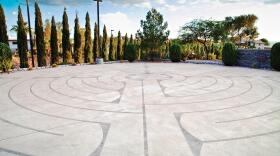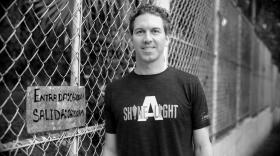Let’s not allow constant change to turn Las Vegas into everywhere else.
The plan was to drive to City. We weren’t exactly certain where it was, and we were absolutely certain that no one would let us in once we got there. But that wasn’t the point. A drive to City fit all the requirements for a thrilling journey to an unattainable destination. A heavily metaphorical Nevada afternoon.
City is a sculpture that also functions as architecture, monumental in size and intention, quite literally an urbanesque complex of earthen geometries and constructed megaliths located in remote Lincoln County. It is one of a number of important examples of Land Art to be found in and around Nevada. Artists like Robert Smithson, Nancy Holt and Walter de Maria looked to the landscape as a kind of canvas, perfectly harnessing the geography and spirit of the West. Apart from challenging the commodity-based and institutional art world systems, the resulting works are highly experiential and, if you dig the Southwest landscape, breathtaking beyond words.
The mastermind behind City, the artist Michael Heizer, began the project in 1970 and has been constructing it ever since. Of course, given that no one is allowed in to see the place, we have until recently only had his word that the project actually exists. A tantalizing what-if, in my mind. The post-Google Earth era has ruptured that bubble by making aerial images of the project available, revealing a partially completed sci-fi masterpiece more appropriate to the planet Arrakis than rural Southern Nevada. They look fake, mystical, Photoshopped and imperfect — like a collection of little alien toys. I imagine standing among its monoliths would feel like being immersed in a giant spectacle made of dirt. Ancient and intergalactic. But I kind of hope I never get the chance because the fits and starts and exceptionally slow yet oddly edge-of-your-seat nature of the process has become, for this outsider, integral to the appeal. I love marginal states.
I’ve spent most of my adulthood living in cities like City — on the cusp. I called Portland, Oregon home at a time when it was shifting from a working-class hippie port town to a mecca of urban youth cool. Dead Heads, electricians, punks and bike messengers all drank together — there was room for everyone at the bar, which isn’t necessarily the case these days. During that time a bumper sticker made the rounds demanding that residents “Keep Portland Weird.” In true PDX fashion, the phrase was condescending enough to suggest an intimate knowledge of weirdness that I had obviously never known, but self-congratulatory enough to presume to be acting in my best interest. By raising awareness about the swelling crisis, it admitted that it needed my help to stop the tidal wave of normalcy. For all of its co-opting of weirdness and implied open-mindedness, it struck me as narrow and a bit fearful. Plus, most of the people who had the bumper sticker weren’t even natives. What did they know from Portland weird? The city was all weird and cool to me. How about “Change is Good,” Bumper Sticker? Don’t tell me what to do, Bumper Sticker.
I’ve been thinking about City and that bumper sticker a lot lately.
The surge of change like gentrification might strike a city once or twice in a generation. But the ebb and flow of transformation is the lifeblood of Las Vegas, the city I call home. It is perhaps most like Heizer’s project, sci-fi in its own way, an earthbound spectacle emerging from the desert in a gloriously constant state of what-if.
There is so much to love about my adopted hometown, and none of it obvious. It is tough, demanding and unforgiving. It can also be impeccably refined. A quick glance through social media confirms that it is neurotically self-obsessed. Come September, this city is beautifully bleached-out by the sun, like a favorite soft T-shirt. The Strip doesn’t care what you think: It dresses up and parties hard, wearing today’s mascara tomorrow, smudged, with pride. It will be anything you want it to be, generously holding your fantasies and realities aloft, pretending at balance. And it lets you be anything you want to be — if you can stand it. I know I will never understand its uniquely American brilliance. Heizer’s City is an iteration of this ever-evolving spectacle in the dirt: raw material, otherworldly context and endless contradictions that make for a thrilling journey to an unattainable destination.
A markedly different kind of transformation is taking hold now in Las Vegas. Lately things feel different and the city looks different — and by different, I mean kind of the same. Small businesses are disappearing and old buildings are being torn down. Things look a bit more homogeneous, as does the clientele. Close your eyes and open them, and you could be in any exciting urban area in any part of the country on the cusp of revitalization. But how much do we want to be like everyone else? Institutionalized change is a journey to an attainable destination, a beautiful one with bright, gorgeous buildings and fabulous amenities available in any other metropolis. Is the native culture shifting, or are recent transitions just harder to recognize? On a recent walk downtown I overheard a tourist observe in amazement, “It doesn’t look like Fremont Street ...?” with a slight question and a bit of sadness that I can’t distinguish from my own.
A gamble on a grand scale is still a gamble, and at its heart the gamble is what makes this town hum. I love it. Over the years, some folks have been brave enough to take a big gamble on downtown, and I am excited to see what happens as the groundswell of change crests, but concerned as I watch change subtly erode the character, people and places that challenge my notions of normalcy and inspire reverence for the tenacity and creativity of the Wild West. It’s a shift I’ve seen happen before, and I hope there is room for everyone to sit at the bar.
One of my favorite drives is a stretch of small homes on Eastern Avenue that have been converted into businesses, the majority of which have taken advertising into their own hands. The businesses share front yards with neighboring single-family homes, quaint and relatively old, and the street bustles with pedestrians of every ethnicity. Some buildings are boldly painted, others framed in LED reader boards with perhaps a giant blow-up mascot or two swaying outside the door. During the day you can see the warts and cracks, but at night it is a sparkling masterpiece of democratic ingenuity residing, like City, somewhere between sculpture and architecture. This urgent and ever-changing menagerie of vibrant colors, logos and lights is a design mashup full of off-the-cuff strategies for catching the eye and conveying an idea, tiny homesteads providing the framework for everyone’s latest dream. This is my hometown.
I didn’t get it before, but I get it now.
Here goes nothing: Keep Vegas Weird









